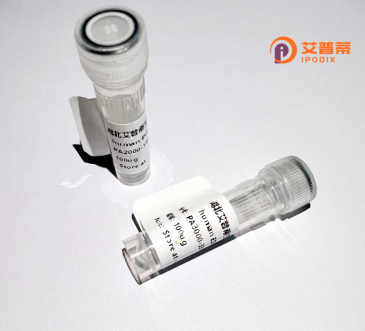
| 纯度 | >90%SDS-PAGE. |
| 种属 | Human |
| 靶点 | SH2D1B |
| Uniprot No | O14796 |
| 内毒素 | < 0.01EU/μg |
| 表达宿主 | E.coli |
| 表达区间 | 1-132 aa |
| 活性数据 | MDLPYYHGRL TKQDCETLLL KEGVDGNFLL RDSESIPGVL CLCVSFKNIV YTYRIFREKH GYYRIQTAEG SPKQVFPSLK ELISKFEKPN QGMVVHLLKP IKRTSPSLRW RGLKLELETF VNSNSDYVDV LP |
| 分子量 | 15.2 kDa |
| 蛋白标签 | His tag N-Terminus |
| 缓冲液 | PBS, pH7.4, containing 0.01% SKL, 1mM DTT, 5% Trehalose and Proclin300. |
| 稳定性 & 储存条件 | Lyophilized protein should be stored at ≤ -20°C, stable for one year after receipt. Reconstituted protein solution can be stored at 2-8°C for 2-7 days. Aliquots of reconstituted samples are stable at ≤ -20°C for 3 months. |
| 复溶 | Always centrifuge tubes before opening.Do not mix by vortex or pipetting. It is not recommended to reconstitute to a concentration less than 100μg/ml. Dissolve the lyophilized protein in distilled water. Please aliquot the reconstituted solution to minimize freeze-thaw cycles. |
以下是关于重组人SH2D1B蛋白的3篇文献摘要概述:
1. **文献名称**: "EAT-2 regulates natural killer cell activation and anti-tumor immunity"
**作者**: Morra M. et al.
**摘要**: 研究发现SH2D1B(即EAT-2)在NK细胞的信号传导中起关键作用,通过结合SLAM家族受体调控细胞毒性活性,并参与抗肿瘤免疫应答。
2. **文献名称**: "SH2D1B (EAT-2) modulates CD150-mediated signaling in T cells"
**作者**: Tangye S.G. et al.
**摘要**: 探讨了SH2D1B与CD150受体的相互作用,揭示其在T细胞激活中的调控功能,以及与SAP蛋白家族协同调节免疫细胞信号通路的机制。
3. **文献名称**: "Structural and functional analysis of SH2D1B in X-linked lymphoproliferative disease"
**作者**: Nichols K.E. et al.
**摘要**: 通过解析SH2D1B的突变与X连锁淋巴增生性疾病(XLP)的关联,阐明其结构域缺陷导致免疫细胞功能失调的分子机制。
(注:若需具体文献来源,可提供论文DOI或PMID进一步检索。)
The SH2D1B protein, also known as EAT-2 (EWS-activated transcript 2), is a signaling lymphocytic activation molecule (SLAM)-associated protein primarily involved in immune regulation. It contains a single Src homology 2 (SH2) domain, enabling interactions with phosphorylated tyrosine residues on cell surface receptors, particularly those in the SLAM family (e.g., CD150. CD84). Expressed predominantly in T cells, natural killer (NK) cells, and dendritic cells, SH2D1B modulates immune synapse formation, cytokine production, and cytotoxic activity. It shares structural homology with SH2D1A (SAP), a related protein whose mutations cause X-linked lymphoproliferative disease (XLP). However, SH2D1B exhibits distinct functional properties, including a proposed regulatory role in fine-tuning immune responses through competitive receptor binding or downstream signaling interference.
Research highlights SH2D1B's involvement in balancing activating and inhibitory signals in immune cells. It associates with adaptor proteins like SHP-1/2 and Grb2 to influence MAPK and PI3K pathways. In NK cells, SH2D1B engagement can suppress excessive activation, suggesting therapeutic relevance in autoimmune disorders and transplant rejection. Conversely, reduced expression has been linked to impaired tumor surveillance, implicating it in cancer immunotherapy strategies. Recombinant SH2D1B protein, produced via bacterial or mammalian expression systems, facilitates structural studies, ligand screening, and mechanistic exploration of SLAM receptor networks. Ongoing research focuses on its role in chronic infections, hematopoietic malignancies, and checkpoint modulation therapies.
×